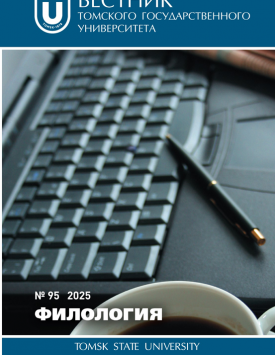Types of explanatory relations in constructions with non-predicative parentheticals
The aim of the study is to develop a classification of explanatory relations in constructions with parentheticals based on logical relations. The research is conducted on the material of Russian literary works of the 19th-20th centuries. Contextual and component analyses were used in the development of the classification. The study involves a comparison of explanatory relations with coordinative and subordinative ones. The specificity of explanation is described as a subject-expressive and subject-oriented form of syntax, serving a metacommunicative function. Explanatory relations are defined as relations that arise between two components (the explained and the explaining) performing the same syntactic function but not connected by coordinating or subordinating conjunctions and not entering into enumeration relations with each other. Based on the analysis of scientific literature and language material, a classification of explanatory relations in constructions with parentheticals was developed. This classification is grounded in correlating the extensions of concepts of the explaining and the explained components. The extension of a concept is viewed as a scale, at one end of which pronouns are located as non-specific words performing an indicative function, with their potential extension approaching infinity; at the other end of this scale are proper nouns, another type of non-specific words, whose function is the unique naming of an object, and their conceptual volume tends towards unity. Content words occupy the intermediate position. Three main types of explanatory relations in constructions with parentheticals are identified: (1) specification (narrowing the extension of the concept when moving from the specified to the specifying); (2) generalization (expanding the extension of the concept); (3) identification (equating the extensions of the concepts). Specification most closely corresponds to the logic of the progressive development of the text: from general to specific, from less information to more. Generalization achieves progressive development of the text through the exchange of characteristics between an element and a set: by endowing the set with the properties of the referent or by endowing the referent with the properties of the set. Identification violates the logic of the progressive development of the text; the informational value of identification is determined by its metalinguistic function, that is, by ensuring the interaction of various signifiers caused by differences in languages, sociolects, idiolects or constitutions. The author declares no conflicts of interests.
Keywords
parentheticals,
explanatory relations,
extension of concept,
specification,
generalization,
identificationAuthors
| Kononova Irina Yu. | Chirchik State Pedagogical University | konirina@inbox.ru |
Всего: 1
References
Кононова И.Ю. Анализ грамматической и лексико-семантической амбивалентности в построениях со вставными конструкциями (на материале художественной прозы М. Цветаевой) // Вестник Московского государственного лингвистического университета. Серия: Гуманитарные науки. 2022. Вып. 4 (859). С. 65-70.
Иванникова Е.А. Вставные предложения, слова и сочетания слов // Грамматика русского языка / под ред. В.В. Виноградова и Е.С. Истриной. М. : Изд-во АН СССР, 1960. Т. 2, ч. 2. С. 165-174.
Распопов И.П., Ломов А.М. Основы русской грамматики. Морфология и синтаксис. Воронеж : Изд-во Воронежского университета, 1984. 352 с.
Полякова Ю.Г. Структура и особенности функционирования вставок в языке газеты : автореф. дис.. канд. филол. наук. Волгоград, 2001. 20 с.
Гавриленко И.И. Дополнительная информация в научных текстах: семантические, синтаксические и просодические особенности : автореф. дис. канд. филол. наук. М., 2004. 24 с.
Кулаковский М.Н. Уточняющие функции вставных конструкций в художественном тексте // Верхневолжский филологический вестник. 2020. № 1 (20). С. 80-85.
Пешковский А.М. Русский синтаксис в научном освещении. М. : Языки славянской культуры, 2001. 544 с.
Морфология современного русского языка : учеб. для высш. учеб. заведений / С.И. Богданов, В.Б. Евтюхин, Ю.П. Князев и др. СПб. : Факультет филологии и искусств СПбГУ, 2009. 634 с.
Камынина А.А. Современный русский язык. Морфология : учеб. пособие для студ. М. : МГУ, 1999. 240 с.
Прияткина А.Ф. Сочинительные связи внутри простого предложения (открытые и закрытые ряды) // Русская грамматика / гл. ред. Н.Ю. Шведова. М. : Наука, 1980. Т. 2. С. 166-180.
Прияткина А. Ф. Пояснение. // Русский язык: Энциклопедия / под ред. Ю.Н. Караулова. М. : Большая российская энциклопедия, 1997. С. 358-359.
Глебская Т.Ф. К вопросу о пояснительной связи в простом предложении // Вестник Томского государственного педагогического университета (TSPU Bulletin). Гуманитарные науки (спецвыпуск). 2000. Вып. 3 (19). С. 66-68.
Селюнина О.А. Сложноподчиненное предложение с придаточным времени и пояснительная конструкция: точки соприкосновения // Вестник Томского государственного университета. Филология. 2010. № 337. С. 23-29.
Прияткина А.Ф. Русский язык: Синтаксис осложненного предложения : учеб. пособие для филол. спец. вузов. М.: Высш. шк., 1990. 176 с.
Логвинова Н.Н. Именные аппозитивные конструкции // Материалы для проекта корпусного описания русской грамматики (http://rusgram.ru). На правах рукописи. М., 2022. URL: http://rusgram.ru/pdf/appositive_logvinova_181020_fmal.pdf.
Петрунина С.П. Пояснительная конструкция со значением общего-частного в сибирских говорах // Вестник Кемеровского государственного университета. Филология. 2015. № 3 (63), т. 1. С. 173-177.
Чуглов В.И. О пояснительных конструкциях и их разновидностях // Вестник Череповецкого государственного университета. Филологические науки. 2011. № 4, Т. 3. С. 127-131.
Петрунина С.П. Грамматика говорящего и слушающего в сибирских говорах (на материале парных конструкций) : автореф. дис.. д-ра филол. наук. Томск, 2008. 45 с.
Quirk R. et al. A Comprehensive Grammar of the English Language. London ; New York : Longman, 1985. 1779 p.
Инькова О.Ю., Гурьев А.С. К вопросу о категории пояснения в русской грамматике // Русский язык в научном освещении. 2018. № 1 (35). С. 46-73.
Mitkov R. Anaphora Resolution. London : Longman, 2002. 235 p.
Kibrik A.A. Reference in Discourse. Oxford : Oxford University Press, 2011. 913 p.
Деликишкина Е.А., Федорова О.В. Влияние фактора синтаксической роли антецедента на разрешение референциальной неоднозначности в русском языке // Компьютерная лингвистика и интеллектуальные технологии: По материалам ежегодной Международной конференции «Диалог». М. : Изд-во РГГУ, 2012. Вып. 11 (18). С. 129-137.
Виноградов В.В. Язык Пушкина. Пушкин и история русского литературного языка. М. ; Л. : Academia, 1935. 490 с.

